"Secret vessel" Peter I: How to built the first military submarine in the world in Russian
• "secret vessel" Peter I: How to built the first military submarine in the world to Russia
The idea of a boat dive under water for a hidden approach and attack on enemy ships attracted warlords since antiquity. According to legend, Alexander the Great used the underwater exploration of the enemy. But the first real combat submarine created a Russian carpenter and inventor Yefim Nikonov, with the direct support of the king-reformer Peter I.

One of the first concepts of the submarine was represented by an Englishman, William Bourne in 1578. But only in 1620 Drebbel Cornelius (Cornelis Drebbel) built the first working example. It was made of wood, was driven by oars and could remain under water for several hours. Air was supplied at special tubes from the surface. Drebbel demonstrated the possibility of dipping their boats, diving on the River Thames, and remained under water for three hours. During this time, thousands of Londoners gathered on the shore, were convinced that the piece of plate sank and the crew have already died.
The Dutch scientist Christiaan Huygens, who witnessed the test, later wrote that it was "a bold invention" may be used during the war to attack enemy ships of the enemy, lying in the direct line of sight, and unaware of the danger. As Huygens, many others have recognized the military potential of submarines. Despite this, it took another hundred years before the first military submarine to be built.

A replica of a submarine Efim Nikonov, standing in Sestroretsk, not far from St. Petersburg on the Neva River.
In 1718, Russian carpenter Prokopievich Yefim Nikonov wrote to Peter I, that I could build a "sanctuary ship" that can swim under water and destroy all enemy ships with cannons. Surprisingly, the king invited Nikonov in St. Petersburg and ordered to start the construction of the vessel.
Nikonov graduated scale model of the first Russian submarine in 1721 and tested it in the presence of Peter. The king was so pleased with the results that he ordered to build a full-size Nikonov secret warship.
Figure "secret vessel" Nikonov.
"Hidden boat" Nikonov was built of wood in the form of barrels. It was armed with flamethrowers. The submarine had to approach the enemy ship, put the ends of the pipe flamethrower out of the water to burn and blow up enemy ships. In addition, it has been provided for the airlock aquanauts who could get out of the submarine and destroy the enemy.
The first test of a full-size submarine was carried out in autumn 1724. It was a disaster. "Hidden boat" sank when reached the bottom and break the board. Nikonov himself and four rowers were inside. It was a real miracle that the crew managed to escape.

The monument sanctuary ship in Sestroretsk.
Peter supported the inventor and called Nikonov improve the design. But the failures have continued to pursue him. The second and third tests of Russian "secret vessel" ended in failure. After the death of its top patron, Nikonov was accused of abusing public funds, was demoted to the ranks and sent carpenters to work at the shipyard on the River Volga.

The full-size layout "Turtles" Bushnell at the Museum of the US Navy submarine force.
The first successful use of a military submarine occurred during the American War of Independence. Submarine under the "Tortoise" (Turtle) was developed by American inventor David Bushnell (David Bushnell). It was egg-shaped device that could accommodate one person.
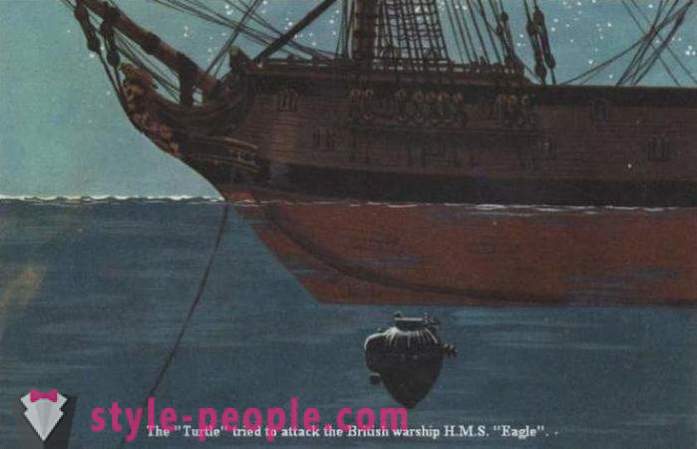
The American submarine "Turtle" is attacking the British battleship HMS Eagle.
In 1776, in New York harbor Sergeant Ezra Lee (Ezra Lee) controlling the "Turtle" tried, but was unable to attach an explosive charge on the British battleship case "Eagle" (HMS Eagle). According to the Americans, Lee was discovered before he could accomplish the combat mission. On the British side as there is no evidence of the attack. It's all in doubt certain historians in the fact of the attack. Some even believe that the "Turtle" is the story around it were created as misinformation and to improve the morale of the colonialists.













































